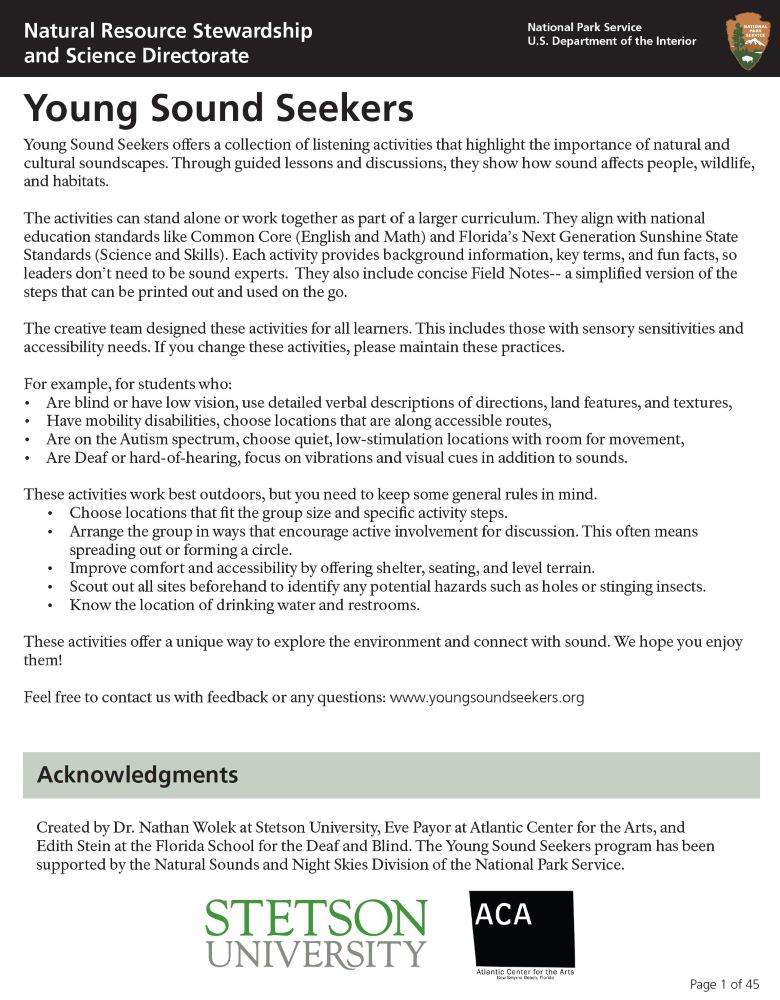Last updated: June 3, 2025
Lesson Plan
Young Sound Seekers Listening Activities -- Complete Collection

Front page for the Young Sound Seekers activities. Click "Download Lesson Plan" to access full file with all 6 educational activities
Young Sound Seekers / NPS Natural Sounds & Night Skies Division
- Grade Level:
- Middle School: Sixth Grade through Eighth Grade
- Subject:
- Literacy and Language Arts,Science,Social Studies
- Lesson Duration:
- 60 Minutes
- Common Core Standards:
- 3.SL.1, 3.SL.2, 3.SL.3, 3.SL.4, 4.SL.1, 4.SL.2, 4.SL.3, 4.SL.4, 5.SL.1, 5.SL.2, 5.SL.3, 5.SL.4, 6.SL.1, 6.SL.2, 6.SL.3, 6.SL.4, 7.SL.1, 7.SL.2, 7.SL.3, 7.SL.4, 8.SL.1, 8.SL.2, 8.SL.3, 8.SL.4, 9-10.SL.1, 9-10.SL.2, 9-10.SL.3, 9-10.SL.4
Essential Question
What can park interpreters, educators, students, and visitors do to learn more about the acoustic environment, enhance our listening skills, and enjoy park soundscapes? Try out this set of 6 educational activities!
Objective
Young Sound Seekers offers a collection of listening activities that highlight the importance of natural and cultural soundscapes. Through guided lessons and discussions, they show how sound affects people, wildlife, and habitats.
Background
Young Sound Seekers offers a collection of listening activities that highlight the importance of natural and cultural soundscapes. Through guided lessons and discussions, they show how sound affects people, wildlife, and habitats.
The activities can stand alone or work together as part of a larger curriculum. They align with national education standards like Common Core (English and Math) and Florida’s Next Generation Sunshine State Standards (Science and Skills). Each activity provides background information, key terms, and fun facts, so leaders don’t need to be sound experts. They also include concise Field Notes-- a simplified version of the steps that can be printed out and used on the go.
The creative team designed these activities for all learners. This includes those with sensory sensitivities and accessibility needs. If you change these activities, please maintain these practices.
For example, for students who:
- Are blind or have low vision, use detailed verbal descriptions of directions, land features, and textures,
- Have mobility disabilities, choose locations that are along accessible routes,
- Are on the Autism spectrum, choose quiet, low-stimulation locations with room for movement,
- Are Deaf or hard-of-hearing, focus on vibrations and visual cues in addition to sounds.
Preparation
These activities work best outdoors, but you need to keep some general rules in mind.
- Choose locations that fit the group size and specific activity steps.
- Arrange the group in ways that encourage active involvement for discussion. This often means spreading out or forming a circle.
- Improve comfort and accessibility by offering shelter, seating, and level terrain.
- Scout out all sites beforehand to identify any potential hazards such as holes or stinging insects.
- Know the location of drinking water and restrooms.
Materials
Procedure
Soundwalk
Attendees experience a contemplative walk for listening awareness. This activity allows listeners to focus and heighten their perception of the sounds in the environment, using their ears as their eyes. Note: this is also an activity suitable for those with hearing loss, but instead focusing on visual and tactile cues of sound vibration.DIP TiPS
People are introduced to vocabulary for describing common features of sounds and demonstrate their understanding of these words by creating original sound events. This activity introduces the task of describing specific features of individual sound events.Echoes of the Past
Attendees identify cultural and natural sounds of their location. The activity addresses how sounds influence culture throughout history and uses listening exercises to identify current and past cultural and natural sounds of their location.Listen, Pair, Share
The group learns to perceive layers and distinguish components of the soundscape around them, while focusing attention completely on the task of listening.Masking Mayhem
Listeners learn about the phenomenon of masking, or when sounds interfere with each other. The activity allows people to experience first-hand how we sometimes have trouble hearing an individual sound in a crowded soundscape.Good Vibes
Listeners are introduced to qualities of sound that affect the health of all living beings, such as the stressors of noise pollution, and the benefits of a balanced soundscape.Related Lessons or Education Materials
Young Sound Seekers individual educational activities
Soundwalk
DIP TiPS
Echoes of the Past
Listen, Pair, Share
Masking Mayhem
Good Vibes
Created by Dr. Nathan Wolek at Stetson University, Eve Payor at Atlantic Center for the Arts, and Edith Stein at the Florida School for the Deaf and Blind. The Young Sound Seekers program has been supported by the Natural Sounds and Night Skies Division of the National Park Service.
